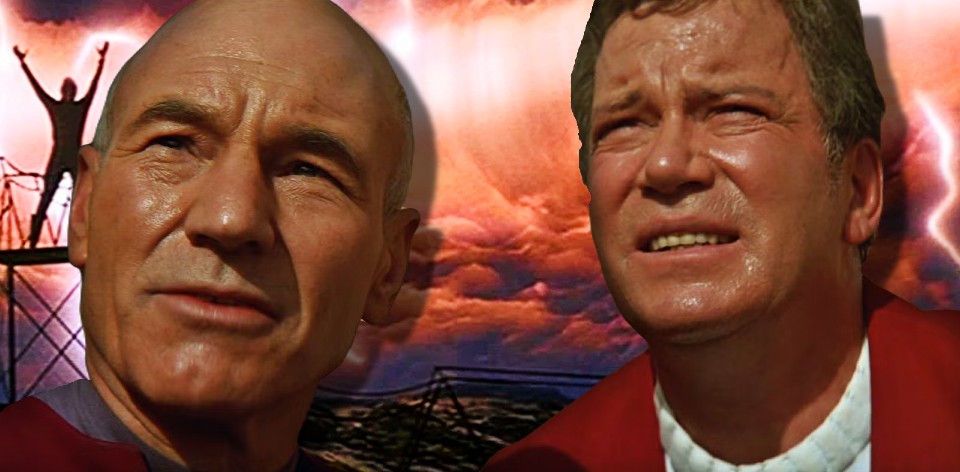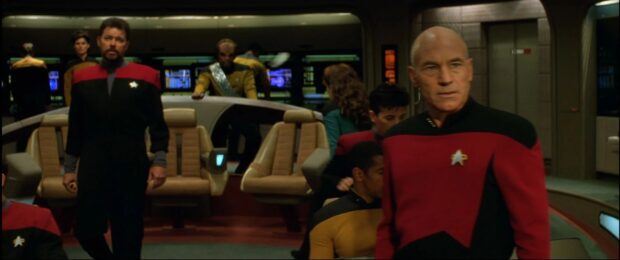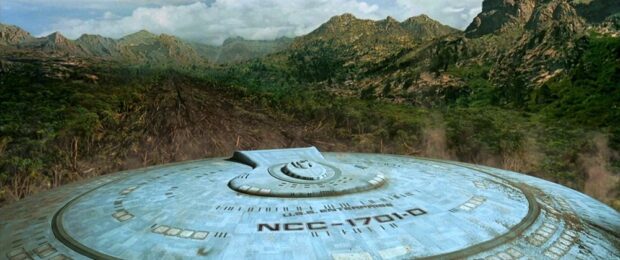I remember when Star Trek Generations hit cinemas. I bought everything—the book, posters, collectible cards, the lot. The film came out just a few years after the franchise’s 25th anniversary, right at the height of my fandom. That younger self would have rated it five stars easily, maybe even six.
But as the years have passed, my fandom has persisted while my critical lens has sharpened. Or arguably grown more cynical. Having rewatched The Next Generation (TNG), Deep Space Nine (DS9), Voyager and Enterprise fairly recently, it’s easier to see the spectrum of what Trek can offer. And Generations is good Trek, though the series has shown us it can be great.
The film’s plot centres around the mysterious Nexus, a moving space-time rift. It was believed to have killed Captain Kirk (William Shatner) aboard the Enterprise-B in 2293 while rescuing refugees from its deadly pull. Yet, almost eight decades later, the Enterprise-D discovers that the Nexus offers those who enter it a surreal paradise where their deepest desires are eternally realised, untouched by the outside world. As refugee Tolian Soran (Malcolm McDowell) relentlessly seeks to return to the Nexus, Jean-Luc Picard and Captain Kirk’s paths cross, and two legends must face both personal and universal stakes to save the galaxy.
A friend recently called Generations “underrated,” and I have to agree. For all its flaws, it’s the best of the “odd-numbered” Trek films by a long shot and truly feels like TNG expanded—visually, emotionally, and logistically. The sets are stunning and meticulously detailed, and the cinematography finally places TNG on a larger-than-life scale.
A prime example is the return of the TNG crew, who had wrapped their final season on television only six months prior. Beginning with Worf’s promotion in a holodeck simulation of an old sailing ship, the film’s $35 million budget is immediately on display. This scale continues through a thrilling space battle with a Klingon Bird of Prey, the massive energy phenomenon of the Nexus, and, ultimately, the Enterprise’s saucer crash-landing onto a planet’s surface.
However, in its attempt to appeal to a broader audience, the film stumbles in places. Like the Nexus itself, Generations surrounds us with comforting things—familiar faces, Klingons, space battles, a Holodeck sequence, and Data’s iconic “Oh shit…”—but the essence of Trek feels just out of reach. As striking as Data’s moment was (and tame now, thanks to Discovery and Picard), some of the humour feels forced, almost poking fun at the characters rather than celebrating them. Data’s emotional subplot, while memorable, feels tacked on, undermining the nuance of his seven-season journey.
Picard, on the other hand, gets to explore his own emotional development. The concept of family repeatedly arises throughout the series, as does the notion of “what ifs.” Much like the sublime Hugo Award-winning Season 5 episode The Inner Light, Picard sees what life would be like if he had had a family and children. His emotional journey is partially fueled by the recent loss of his brother Robert and young nephew René in a fire, leaving him as the last of the Picards.
And of course, there’s the long-awaited meeting between Kirk and Picard. The Nexus presents this as a meeting of two explorers at different stages in their careers, both contemplating life regrets. It’s a goldmine of potential emotion, but the interaction never quite lands. The scenes feel more like a horseback compromise between eras than an organic meeting. In hindsight, it would have only taken a few more scenes to develop Kirk’s journey further, instead of the retrospectively cheap shot of killing off a legend. (In fact, I still found the journey between Data and his cat Spot more emotional).
Nevertheless, the Nexus as a means of examining life choices, morality, and legacy is precisely what Star Trek—and certainly TNG—is all about. Think about the sixth season episode Tapestry, where the immortal being Q (John de Lancie) allows Picard to revisit a pivotal moment in his life and watch the ripple effects. In that episode, Picard declares he would rather die as Captain than live a life of safety and mediocrity. Here, the Nexus offers a similar opportunity for characters to reconsider their paths, but its exploration feels somewhat underdeveloped in the film’s broader context.
TNG’s potential on the big screen came into full focus just a few years later with First Contact, arguably the finest of the TNG films, and then with Insurrection, which feels like a feature-length episode in the best sense. Nemesis, of course, did its own thing. But there’s still something about Generations that resonates with me. Even now, part of me is still that teenager seeing it for the first time in the cinema, wide-eyed at the scale and familiar faces. And he wouldn’t care about these quibbles—he’s just thrilled to be along for the ride.
Engage.
Star Trek Generations was released in the United states on was released in the United States on 18 November 1994. The Internet tells me that we didn’t see the film in Australia until 30 March 1995 — by which stage I’d already devoured the novelisation several times. Elements of this review originally appeared in a Letterboxd review in June 2020 — probably following a lockdown TNG binge.








